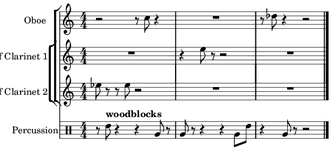title "Settings" author "David Psenicka" quartertones yes // score-level settings end here time 0 dur 2 pitch 59.5 staff 1 ; // `staff' is a note event setting time 3 dur 2 pitch 60.5 staff 2 ; |

|
Figure 6.17: Score-Level Settings
The following
example contains
three score-level settings, title, author and quartertones, which affect the entire score.
All setting assignments at the top of the file are interpretted as score-level settings.
As soon as anything other than a setting definition is encountered (e.g., an instrument/part definition or the first parameter of a note event),
setting assignments outside of an object definition are interpretted as note event settings.
All settings in FOMUS can be set at the score level.
title "Settings" author "David Psenicka" quartertones yes // score-level settings end here time 0 dur 2 pitch 59.5 staff 1 ; // `staff' is a note event setting time 3 dur 2 pitch 60.5 staff 2 ; |

|
Figure 6.17: Score-Level Settings
Each list of keyword/argument pairs following the percinsts, insts and parts keywords is the definition for a percussion instrument, instrument or part.
See Objects for a better explanation of these objects—the purpose here is only to point out settings.
perc-note and perc-name are typical settings for percussion instruments (they specify the note and the text for a percussion change mark).
Because they are set in a percussion instrument definition, they affect only that object and any woodblock percussion note events.
The settings name and abbr usually belong in an instrument definition (they are the name and abbreviated name of the instrument).
When they are defined in a part as they are here, they override the definitions that are in the instrument that they are based on.
transpose-part (whether or not to transpose all of the notes in a part)
should probably be defined at the score level, but can also exist in instruments or parts (as they are here).
id, template, percinsts (inside the instrument definition) and insts (inside the part definitions)
aren't really settings—they are special assignments that only affect the instrument or part that they are defined in
(see Objects for complete lists and descriptions of these special parameters).
layout = orchestra percinst <id wb1, template low-woodblock, perc-name woodblocks, perc-note a3> percinst <id wb2, template high-woodblock, perc-name woodblocks, perc-note e4> inst <id prcdef, template percussion, percinsts (wb1 wb2)> part <id cl1, name "Bf Clarinet 1", abbr "cl 1", transpose-part no, inst bflat-clarinet> part <id cl2, name "Bf Clarinet 2", abbr "cl 2", transpose-part no, inst bflat-clarinet> part <id ob, name Oboe, abbr ob, inst oboe> part <id prc, name Percussion, abbr perc, inst prcdef> part cl1 time 0 duration 4 || time 5 voice 1 duration 1/2 pitch 76 ; part cl2 time 0 duration 4 || voice 1 duration 1/2 pitch 75 ; time 1+1/2 voice 1 duration 1/2 pitch 75 ; part ob time 0 duration 4 || time 2+1/2 voice 1 duration 1/2 pitch 72 ; time 8+1/2 voice 1 duration 1/2 pitch 73 ; part prc time 0 duration 4 || time 1/2 voice 1 duration 1/2 pitch wb2 ; time 3 voice 1 duration 1/2 pitch wb1 ; time 4 voice 1 duration 1/2 pitch wb1 ; time 7 voice 1 duration 1/2 pitch wb1 ; time 7+1/2 voice 1 duration 1/2 pitch wb2 ; time 9 voice 1 duration 1/2 pitch wb1 ; |

|
Figure 6.18: Object Settings
This
example
shows a few settings being defined in measure and note events.
The two settings in the measure definition are comp (compound meter) and keysig (key signature), both of which
could be set at the score level or in a part definition instead.
The settings in the note events are staff (staff number) and acc (accidental choices), which override any decision FOMUS makes regarding
staff and accidental choices.
They must appear on every note entry or in a region definition (both are shown in the example).
|

|
Figure 6.19: Measure/Note Settings